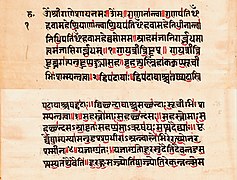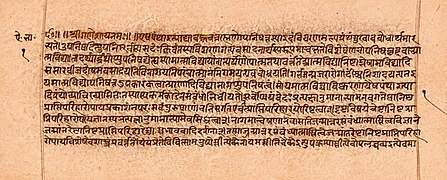
A | B | C | D | E | F | G | H | CH | I | J | K | L | M | N | O | P | Q | R | S | T | U | V | W | X | Y | Z | 0 | 1 | 2 | 3 | 4 | 5 | 6 | 7 | 8 | 9
| Devanāgari देवनागरी | |
|---|---|
 Devanāgarī script (vowels top three rows, consonants below) | |
| Script type | |
Time period | 12th century CE to present[1][2] |
| Direction | Left-to-right |
| Region | India and Nepal (Official) Fiji (Co-official) |
| Languages | Apabhramsha, Angika, Awadhi, Bajjika, Bhili, Bhojpuri, Boro, Braj, Chhattisgarhi, Dogri, Garhwali, Haryanvi, Hindi, Kashmiri, Khandeshi, Konkani, Kumaoni, Magahi, Maithili, Marathi, Marwari, Mundari, Nagpuri, Newari, Nepali, Pāli, Pahari, Prakrit, Rajasthani, Sanskrit, Santali, Saraiki, Sherpa, Sindhi, Surjapuri, and many more. |
| Related scripts | |
Parent systems | |
Sister systems | Nandināgarī Kaithi Gujarātī Moḍī |
| ISO 15924 | |
| ISO 15924 | Deva (315), Devanagari (Nagari) |
| Unicode | |
Unicode alias | Devanagari |
| U+0900–U+097F Devanagari, U+A8E0–U+A8FF Devanagari Extended, U+11B00–11B5F Devanagari Extended-A, U+1CD0–U+1CFF Vedic Extensions | |
| Brahmic scripts |
|---|
| The Brahmi script and its descendants |
| Part of a series on | |
|---|---|
| |
| Writing systems used in India | |
| Brahmic scripts | |
| Arabic derived scripts | |
| Alphabetical scripts | |
| Related | |
Devanagari (/ˌdeɪvəˈnɑːɡəri/ DAY-və-NAH-gər-ee; देवनागरी, IAST: Devanāgarī, Sanskrit pronunciation: [deːʋɐˈnaːɡɐriː]) is an Indic script used in the northern Indian subcontinent. Also simply called Nāgari (Sanskrit: नागरि, Nāgari),[8] it is a left-to-right abugida (a type of segmental writing system),[9] based on the ancient Brāhmi script.[10] It is one of the official scripts of the Republic of India and Nepal. It was developed and in regular use by the 8th century CE[8] and achieved its modern form by 1200 CE.[11] The Devanāgari script, composed of 48 primary characters, including 14 vowels and 34 consonants,[12] is the fourth most widely adopted writing system in the world,[13] being used for over 120 languages.[14]
The orthography of this script reflects the pronunciation of the language.[14] Unlike the Latin alphabet, the script has no concept of letter case.[15] It is written from left to right, has a strong preference for symmetrical rounded shapes within squared outlines, and is recognisable by a horizontal line, known as a शिरोरेखा śirorekhā, that runs along the top of full letters.[9] In a cursory look, the Devanāgarī script appears different from other Indic scripts, such as Bengali-Assamese or Gurmukhi, but a closer examination reveals they are very similar except for angles and structural emphasis.[9]
Among the languages using it as a primary or secondary script are Marathi, Pāḷi, Sanskrit,[16] Hindi,[17] Boro, Nepali, Sherpa, Prakrit, Apabhramsha, Awadhi, Bhojpuri, Braj Bhasha,[18] Chhattisgarhi, Haryanvi, Magahi, Nagpuri, Rajasthani, Khandeshi, Bhili, Dogri, Kashmiri, Maithili, Konkani, Sindhi, Nepal Bhasa, Mundari, Angika, Bajjika and Santali.[14] The Devanāgarī script is closely related to the Nandināgarī script commonly found in numerous ancient manuscripts of South India,[19][20] and it is distantly related to a number of southeast Asian scripts.[14]
Etymology
Devanāgarī is formed by the addition of the word deva (देव) to the word nāgarī (नागरी). Nāgarī is an adjective derived from nagara (नगर), a Sanskrit word meaning "town" or "city," and literally means "urban" or "urbane".[21] The word Nāgarī (implicitly modifying lipi, "script") was used on its own to refer to a North Indian script, or perhaps a number of such scripts, as Al-Biruni attests in the 11th century; the form Devanāgarī is attested later, at least by the 18th century.[22] The name of the Nandināgarī script is also formed by adding a prefix to the generic script name nāgarī. The precise origin and significance of the prefix deva remains unclear.
History
Devanāgarī is part of the Brahmic family of scripts of India, Nepal, Tibet, and Southeast Asia.[23][24] It is a descendant of the 3rd century BCE Brāhmī script, which evolved into the Nagari script which in turn gave birth to Devanāgarī and Nandināgarī. Devanāgarī has been widely adopted across India and Nepal to write Sanskrit, Marathi, Hindi, Central Indo-Aryan languages, Konkani, Boro, and various Nepalese languages.
Some of the earliest epigraphic evidence attesting to the developing Sanskrit Nāgarī script in ancient India is from the 1st to 4th century CE inscriptions discovered in Gujarat.[10] Variants of script called nāgarī, recognisably close to Devanāgarī, are first attested from the 1st century CE Rudradaman inscriptions in Sanskrit, while the modern standardised form of Devanāgarī was in use by about 1000 CE.[11][25] Medieval inscriptions suggest widespread diffusion of Nāgarī-related scripts, with biscripts presenting local script along with the adoption of Nāgarī scripts. For example, the mid 8th-century Pattadakal pillar in Karnataka has text in both Siddha Matrika script, and an early Telugu-Kannada script; while, the Kangra Jawalamukhi inscription in Himachal Pradesh is written in both Sharada and Devanāgarī scripts.[26]
The Nāgarī script was in regular use by the 7th century CE, and it was fully developed by about the end of first millennium.[8][11] The use of Sanskrit in Nāgarī script in medieval India is attested by numerous pillar and cave-temple inscriptions, including the 11th-century Udayagiri inscriptions in Madhya Pradesh,[27] and an inscribed brick found in Uttar Pradesh, dated to be from 1217 CE, which is now held at the British Museum.[28] The script's prototypes and related versions have been discovered with ancient relics outside India, in places such as Sri Lanka, Myanmar and Indonesia. In East Asia, the Siddhaṃ matrika script (considered as the closest precursor to Nāgarī) was in use by Buddhists.[16][29] Nāgarī has been the primus inter pares of the Indic scripts.[16] It has long been used traditionally by religiously educated people in South Asia to record and transmit information, existing throughout the land in parallel with a wide variety of local scripts (such as Moḍī, Kaithi, and Mahajani) used for administration, commerce, and other daily uses.
Sharada remained in parallel use in Kashmir. An early version of Devanāgarī is visible in the Kutila inscription of Bareilly dated to VS 1049 (992 CE), which demonstrates the emergence of the horizontal bar to group letters belonging to a word.[1] One of the oldest surviving Sanskrit texts from the early post-Maurya period consists of 1,413 Nāgarī pages of a commentary by Patanjali, with a composition date of about 150 BCE, the surviving copy transcribed about 14th century CE.[30]
| k- | kh- | g- | gh- | ṅ- | c- | ch- | j- | jh- | ñ- | ṭ- | ṭh- | ḍ- | ḍh- | ṇ- | t- | th- | d- | dh- | n- | p- | ph- | b- | bh- | m- | y- | r- | l- | v- | ś- | ṣ- | s- | h- | |
| Brahmi | 𑀓 | 𑀔 | 𑀕 | 𑀖 | 𑀗 | 𑀘 | 𑀙 | 𑀚 | 𑀛 | 𑀜 | 𑀝 | 𑀞 | 𑀟 | 𑀠 | 𑀡 | 𑀢 | 𑀣 | 𑀤 | 𑀥 | 𑀦 | 𑀧 | 𑀨 | 𑀩 | 𑀪 | 𑀫 | 𑀬 | 𑀭 | 𑀮 | 𑀯 | 𑀰 | 𑀱 | 𑀲 | 𑀳 |
| Gupta | |||||||||||||||||||||||||||||||||
| Devanagari | क | ख | ग | घ | ङ | च | छ | ज | झ | ञ | ट | ठ | ड | ढ | ण | त | थ | द | ध | न | प | फ | ब | भ | म | य | र | ल | व | श | ष | स | ह |
| Devanāgarī |
|---|
 |





